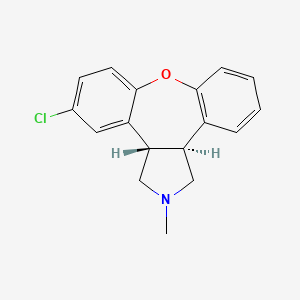Attribution Statement: LactMed is a registered trademark of the U.S. Department of Health and Human Services.
NCBI Bookshelf. A service of the National Library of Medicine, National Institutes of Health.
Drugs and Lactation Database (LactMed®) [Internet]. Bethesda (MD): National Institute of Child Health and Human Development; 2006-.
CASRN: 65576-45-6

Drug Levels and Effects
Summary of Use during Lactation
No information is available on the use of asenapine during breastfeeding. If asenapine is required by the mother, it is not a reason to discontinue breastfeeding. However, an alternate drug may be preferred, especially while nursing a newborn or preterm infant.
Drug Levels
Maternal Levels. Relevant published information was not found as of the revision date.
Infant Levels. Relevant published information was not found as of the revision date.
Effects in Breastfed Infants
Patients enlisted in the National Pregnancy Registry for Atypical Antipsychotics who were taking a second-generation antipsychotic drug while breastfeeding (n = 576) were compared to control breastfeeding patients who were not treated with a second-generation antipsychotic (n = 818). Of the patients who were taking a second-generation antipsychotic drug, 60.4% were on more than one psychotropic. A review of the pediatric medical records, no adverse effects were noted among infants exposed or not exposed to second-generation antipsychotic monotherapy or to polytherapy.[1] The number of women taking asenapine was not reported.
Effects on Lactation and Breastmilk
Galactorrhea has been reported with asenapine according to the manufacturer. Hyperprolactinemia appears to be the cause of the galactorrhea. The hyperprolactinemia is caused by the drug's dopamine-blocking action in the tuberoinfundibular pathway. The maternal prolactin level in a mother with established lactation may not affect her ability to breastfeed.
Patients enlisted in the National Pregnancy Registry for Atypical Antipsychotics who were taking a second-generation antipsychotic drug while breastfeeding (n = 576) were compared to control breastfeeding patients who had primarily diagnoses of major depressive disorder and anxiety disorders, most often treated with SSRI or SNRI antidepressants, but not with a second-generation antipsychotic (n = 818). Among women on a second-generation antipsychotic, 60.4% were on more than one psychotropic compared with 24.4% among women in the control group. Of the women on a second-generation antipsychotic, 59.3% reported “ever breastfeeding” compared to 88.2% of women in the control group. At 3 months postpartum, 23% of women on a second-generation antipsychotic were exclusively breastfeeding compared to 47% of women in the control group.[1] The number of women taking asenapine was not reported.
Alternate Drugs to Consider
References
- 1.
- Viguera AC, Vanderkruik R, Gaccione P, et al. Breastfeeding practices among women taking second-generation antipsychotics: findings from the National Pregnancy Registry for Atypical Antipsychotics. Arch Womens Ment Health. 2022;25:511–6. [PubMed: 34318375]
Substance Identification
Substance Name
Asenapine
CAS Registry Number
65576-45-6
Disclaimer: Information presented in this database is not meant as a substitute for professional judgment. You should consult your healthcare provider for breastfeeding advice related to your particular situation. The U.S. government does not warrant or assume any liability or responsibility for the accuracy or completeness of the information on this Site.
- User and Medical Advice Disclaimer
- Drugs and Lactation Database (LactMed) - Record Format
- LactMed - Database Creation and Peer Review Process
- Fact Sheet. Drugs and Lactation Database (LactMed)
- Drugs and Lactation Database (LactMed) - Glossary
- LactMed Selected References
- Drugs and Lactation Database (LactMed) - About Dietary Supplements
- Breastfeeding Links
- PubChem SubstanceRelated PubChem Substances
- PubMedLinks to PubMed
- Physico-chemical properties and stability of trans-5-chloro-2-methyl-2,3,3a,12b-tetrahydro-1H- dibenz[2,3:6,7]oxepino[4,5-c]pyrrolidine maleate.[Arzneimittelforschung. 1990]Physico-chemical properties and stability of trans-5-chloro-2-methyl-2,3,3a,12b-tetrahydro-1H- dibenz[2,3:6,7]oxepino[4,5-c]pyrrolidine maleate.Funke CW, Hindriks H, Sam AP. Arzneimittelforschung. 1990 May; 40(5):536-9.
- Neurochemical studies with the potential antipsychotic compound trans-5-Chloro-2-methyl-2,3,3a,12b-tetrahydro-1H- dibenz[2,3:6,7]oxepino[4,5-c]pyrrolidine maleate.[Arzneimittelforschung. 1990]Neurochemical studies with the potential antipsychotic compound trans-5-Chloro-2-methyl-2,3,3a,12b-tetrahydro-1H- dibenz[2,3:6,7]oxepino[4,5-c]pyrrolidine maleate.De Boer T, Tonnaer JA, De Vos CJ, Van Delft AM. Arzneimittelforschung. 1990 May; 40(5):550-4.
- Behavioural pharmacology of trans-5-chloro-2-methyl-2,3,3a,12b-tetrahydro- 1H-dibenz[2,3:6,7]oxepino-[4,5-c]pyrrolidine maleate, a compound interacting with dopaminergic and serotonergic receptors.[Arzneimittelforschung. 1990]Behavioural pharmacology of trans-5-chloro-2-methyl-2,3,3a,12b-tetrahydro- 1H-dibenz[2,3:6,7]oxepino-[4,5-c]pyrrolidine maleate, a compound interacting with dopaminergic and serotonergic receptors.Broekkamp CL, De Graaf JS, van Delft AM. Arzneimittelforschung. 1990 May; 40(5):544-9.
- Review Apomorphine.[Drugs and Lactation Database (...]Review Apomorphine.. Drugs and Lactation Database (LactMed®). 2006
- Review Frovatriptan.[Drugs and Lactation Database (...]Review Frovatriptan.. Drugs and Lactation Database (LactMed®). 2006
- Asenapine - Drugs and Lactation Database (LactMed®)Asenapine - Drugs and Lactation Database (LactMed®)
Your browsing activity is empty.
Activity recording is turned off.
See more...
